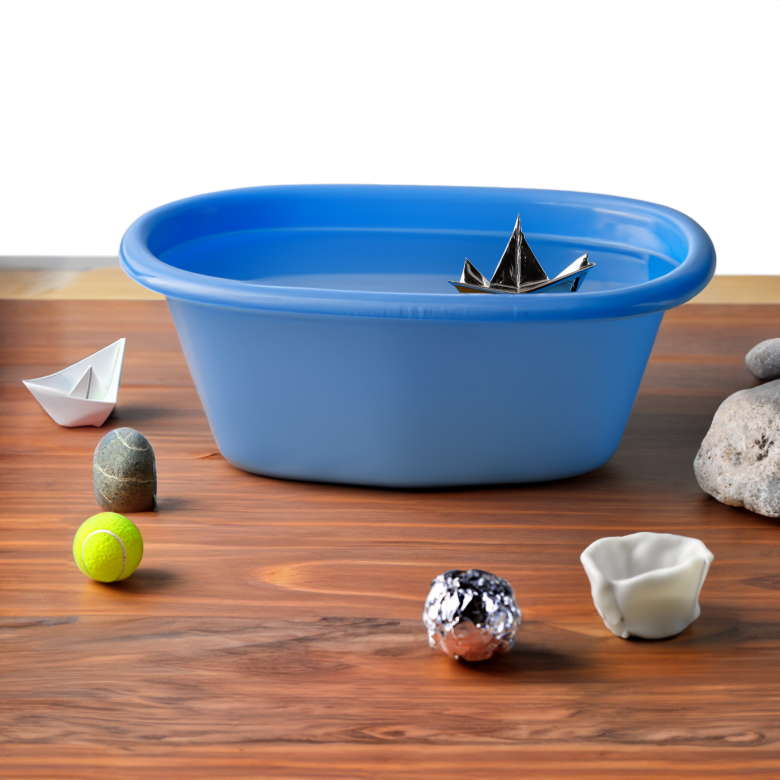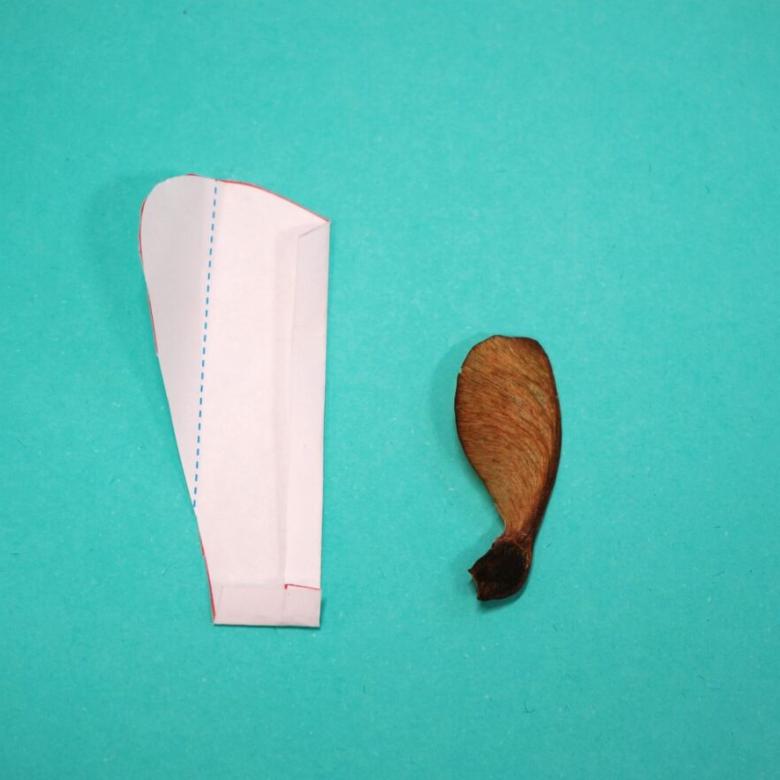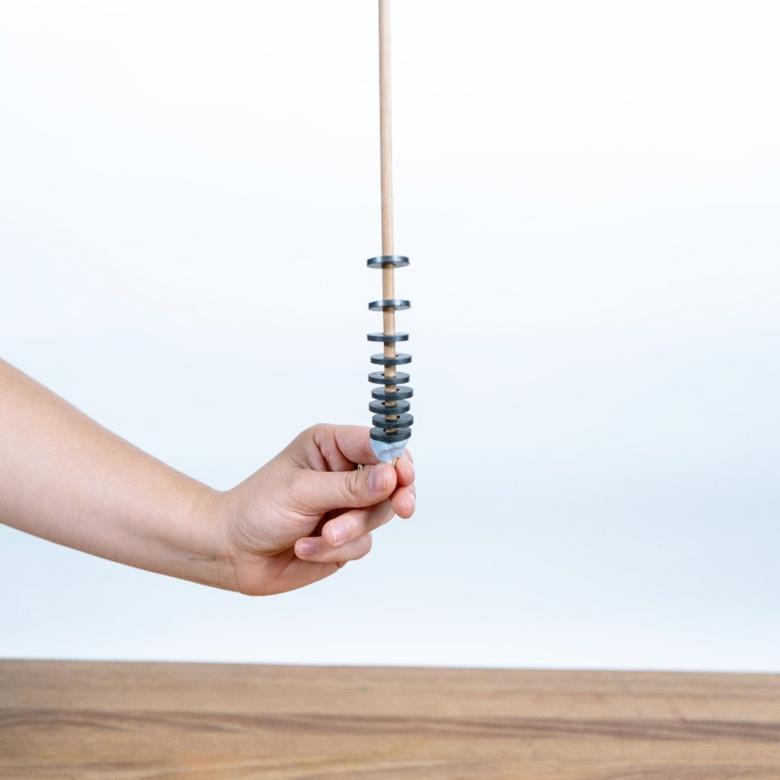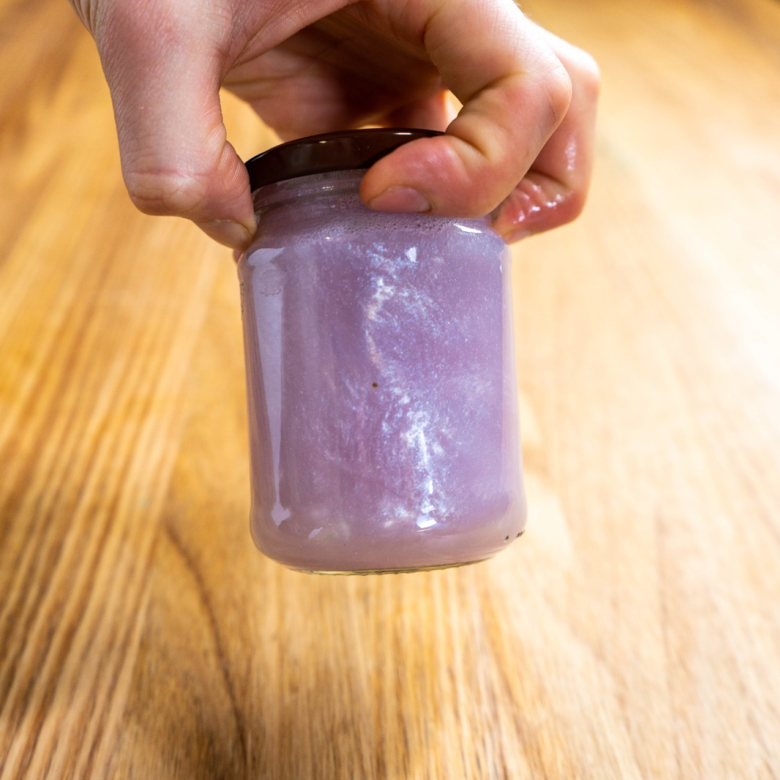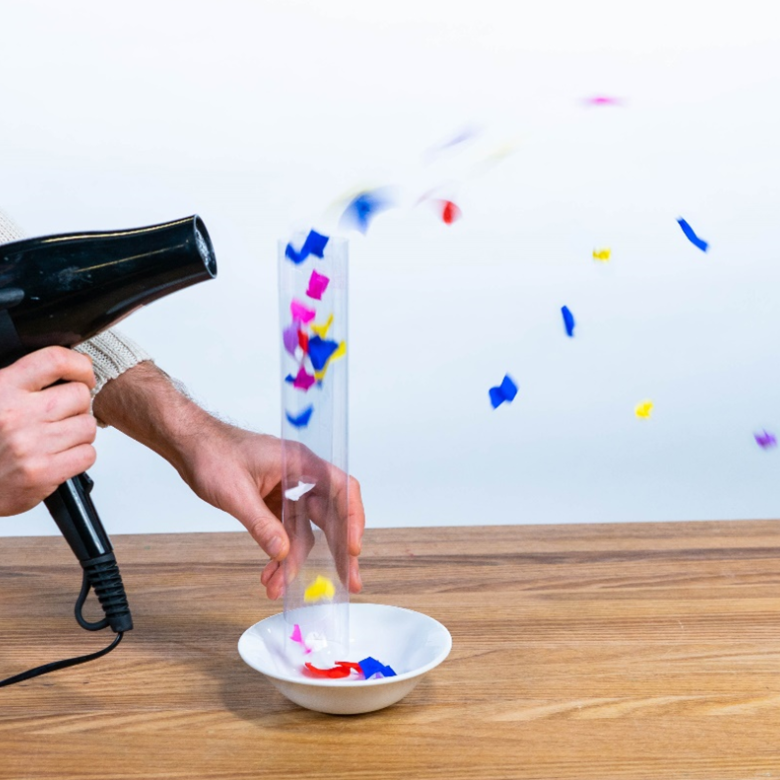You’ll need
- A big plastic tub
- Water
- Things that float or sink, like rocks, sticks, Lego, ping-pong balls and golf balls
- A tall, small plastic cup
- A permanent marker
- A plastic lid to a takeaway container
- Materials to make your boat. Something that floats, like sticks, a plastic container or aluminium foil, and tape, rubber bands or string
- Masking tape
What to do
Part A
- Place your materials on a flat surface.
- Fill your plastic tub about three-quarters full of water. (You can also do this part of the experiment during bathtime.)
- Think about what might happen when you drop the things you have collected into the water. Do you think they will float or sink? Put the different objects in the water to see which of them float or sink. See if your guess was right.
- Sort the objects into 2 groups: floating and sinking. Think about what makes these objects similar and different, and why some float and some don’t.
- Now make sure the plastic cup is about three-quarters full of water. Mark the water line with a marker.
- Drop rocks in one by one. Watch what happens to the water level.
Part B
- Using the same tub of water as for part A, place the plastic lid on top of the water so it’s flat on the water. What happens?
- Now try putting the plastic lid in the water again. But this time, put it in the water on its side. Now what happens?
- Make a boat out of something that floats. You may need to try a few different things, or try making several boats to see which is best!
Questions to ask
Part A
Could you guess which objects will float and which will sink? What did the things in the 2 groups have in common?
Where else can you see water levels changing? Try the experiment again, but with you in a bathtub! (Instead of marking the level with the permanent marker, use masking tape)
Part B
Why does the plastic lid float one way but not the other? Try the same thing with other things you think float.
How much weight can your boat carry? Try placing rocks on your boat. How many rocks can it hold?
Can you improve your boat design so it holds more weight? Experiment with:
- shape – design, build and test different shaped boats. Try boats with sides or flat rafts. You could compare boats with flat and rounded bottoms. How does the shape of a boat affect how it floats or how much weight it can hold?
- materials – design and build boats using a variety of materials, like a plastic container or sticks tied together to make a raft. Does the material you use float or sink? How does this affect how well the boat floats? Test each boat to discover which materials work best
- size – design, build and test differently sized boats. How does the size of the boat affect how it floats or how much weight it can hold?
What's happening
When something goes into water it pushes water out of the way to make room for itself. This is called displacement. To float, an object must displace water that weighs as much as the object. Boats are designed to have a shape that displaces a lot of water. When a boat sits on water, it displaces its own weight in water. The displaced water pushes up, allowing even heavy boats to float.
Objects that are very dense (which means they are heavy for their size) cannot displace enough water to float. Light objects can. That’s why a ping-pong ball floats and a golf ball sinks. They are about the same size and shape, but one is much heavier than the other. That makes it denser, and it sinks.
Some ships are so huge it seems like they shouldn’t float! But, the ocean is waaaaaay bigger than any ship, so there is always enough displaced water to create the upwards pressure needed to float a boat.
Experiment at home
(Children) Boats.
(BJ) Hi, I’m BJ.
Welcome to Science Time, Experimenting at Home.
Do you like experimenting?
I do and at home we can do lots of different science experiments.
Today we’re experimenting with boats.
Do you like boats?
Have you ever seen a boat on the water?
Have you ever been in a boat when it’s on the water?
They’re lots of fun aren’t they?
Here I’ve got a rock.
So, we’re going to do some experimenting with water.
What do you think will happen to this rock when I put it in the water?
Let’s do an experiment and find out.
When you do an experiment in science you start by asking question,
having a bit of a think about what you think might happen,
and then you can do a test to find out.
So, what will happen when we put the rock in the water?
Have you had a think?
Shall we test?
Oop, it sank to the bottom.
Float or Sink
Is that what you thought was going to happen?
Yeah.
Lots of things when you put them in water they’ll either float or sink.
You can do some floating and sinking experimenting at home.
You can get a tank of water like this one
or you can use anything that holds water,
little containers,
or the bath is a great place for doing floating and sinking experiments.
So, I’ve got a question,
why does this little rock sink to the bottom of the water
when a big, heavy boat will float on top of the water?
How does that happen?
Let’s do some more experimenting and find out.
So, here I’ve got a container with water.
And do you notice I’ve put some blue tape here
at the top of the water and that marks where the level of water is.
Now, what happens to water when we put something in it?
Let’s test and find out.
So, here I’ve got a whole bunch of rocks.
Let’s put some rocks in the water and see what happens to the water.
So one, can you count with me? Let’s count together.
Ready, one, two,
three, four…
what’s happening to the water… five, six.
Can you see what’s happening to the level of water?
Is it still on the blue line?
It’s gone above the line hasn’t it.
So, the water level has risen.
When I put the rocks in the water they need to make room for themselves
so the rocks push the water out of the way and it displaces that water.
The water’s got to go somewhere
so it comes up and it makes the water level rise.
You can experiment with this at home in the bathtub.
Next time you have a bath ask your grown up to mark the level of water
with some tape like this or a little waterproof pen
and then get into the bath and see what happens to the water level.
I wonder what will happen.
You can experiment at home and find out.
So, how does pushing water out of the way
make things float like big, heavy boats?
Let’s do some more experimenting.
So, here I’ve got two balls, a ping-pong ball and a golf ball.
Have you ever seen ping-pong ball and golf ball?
They’re the same size.
They’re the same shape but there’s something that’s different about them,
the weight.
The ping-pong ball just has air inside so it’s very light
whereas the golf ball has rubber inside and that makes it quite heavy.
So, one is heavy and one is light.
Do you think that will make a difference
when I put them in the water?
Let’s experiment.
I’ll get the rock out.
What do you think is going to happen
when we put our golf ball and our ping-pong ball in the water?
Let’s test and find out.
Weight
Oop, what happened?
The ping-pong ball floated on top
but the golf ball sank to the bottom of the water.
They’re both pushing water out of the way
and water also weighs a bit as well.
If something is lighter
than the amount of water it pushes out of the way
like our ping-pong ball it will float on top of the water.
But if it’s heavier than the amount of water it pushes away,
like our golf ball, it will sink to the bottom.
So weight has a bit to do with why big boats float.
But boats can be pretty heavy can’t they?
So, it can’t just be the weight.
Let’s do more experimenting.
I’ll get these balls out of the water.
Now, I’ve got a container lid.
You’ll probably have one of these at home in your kitchen.
I’ve put a black cross on it so we can see it well on the video.
So, what will happen when we put this lid in the water.
What do you think?
Let’s test and find out.
Oop, it floats, it floats on top of the water.
Float
OK well let’s put our lid in a different way.
We’ll put it this way.
What do you think will happen?
Let’s experiment and find out.
Did you see that?
Hey, we’ll do it again, watch.
It sank.
So, why did the lid float one way and sink the other way?
Mm, when we put it this way
only this little edge here is pushing water out of the way
so it doesn’t push much water
and the lid is heavier than the little amount of water that it pushed away.
But if we hold it like this with a big, flat surface here,
it’s pushing more water out of the way
and now it’s lighter than the amount of water it’s pushed out of the way
and it will float.
So, boats need to push a lot of water out of the way
when they are on the water in order to float.
Now, lots of boats have big bits like this
under the water that push lots of water out of the way
and makes the boat float.
Now, you can make a boat out of all different sorts of materials at home.
You can do your floating and sinking experiments
and maybe make a boat out of something that floats.
So here, I’ve got a stick.
What will happen when I put the stick in the water?
What do you think?
Do you think it will float or sink?
Let’s test and find out.
Boats
It floats.
So, sticks are really good things to make boats out of.
Here I’ve collected a bunch of sticks from the garden
and I wonder if my little stick boat will float.
You can make a stick boat at home and find out.
Now, other materials we could use
is foil.
You might have some foil in your cupboard at home.
Now, both these pieces are exactly the same size.
So, they’re the same weight
and made out of the same materials
but I’m going to make two different boat designs.
This one I’m going to fold up like this and make a nice flat raft.
But this one I’ll fold up, and instead of being flat,
this one I’m going to make with sides.
Have the boats that you’ve seen,
have they been flat, or have they had sides?
Mm, so this one has sides.
So, do you see what I’ve done there?
You can get your grown-up to help you with this.
I’ve folded up the edges and now it has sides.
So, we’ve got our flat raft and our boat with sides.
What do you think will happen when we put them in the water?
Shall we test?
Oop, look they both float really well.
Now, at home a great experiment you can do
is try to build a boat that will carry the most weight.
So, I’ve got some rocks here.
We’ll get our rocks from before
and let’s see how much weight our raft
and our boat with sides will hold.
So, we’ll do one rock on each.
OK, ready.
Oh, they’re both floating.
Shall we try a second rock?
Here we go.
Oh, our boat with sides is floating.
Oh no, what happened to our raft?
It sank.
But our other boat is still floating really well.
I wonder how many more rocks we can put in it before it sinks.
Shall we keep going?
So, we’ve got two, three, oh, three rocks it held.
So, at home you can experiment with
boats made of foil just like this,
or you can use other things as well.
Containers like a milk bottle are really good,
and you can put it in the water and see
how many of your toys you can put in your boat before it sinks.
Another fun thing to do with boats is to make them move.
So, I’ve got my little container boat here
and how could I make the boat move?
I could push it;
there it goes to the other side.
Is there any other way we could make our boat move?
Maybe we could put something on the boat, something like a sail.
Have you ever seen a sail boat with big sails
that catch the wind and make the boat move?
You can make a sail out of all different sorts of things.
So, here I’ve made a sail out of paper
and I’ve also made a sail out of a leaf.
You could use all different things
and you just need something to put your sail on like a mast it’s called.
Here I’ve used a stick or a wooden stick here.
You could even use a pencil, anything that’s straight.
And you could put it on your boat and then you can be the wind
and you can attach your sail to your boat and do a big blow
and see how far you can move your boat.
And you can experiment with what you make the sail out of,
also the different shapes of sail.
You could use a square one, a rectangle one, even a triangle sail,
and see how that changes the way your boat moves.
There’s so much experimenting you can do with boats at home.
And I want to see your experiments.
So, you can take a video like I have today, or take a photo.
Send them to us on our email or post them online.
There’s so much fun you can do experimenting at home.
So, I’m going to put my sail on my boat
and see how far I can make it move.
You have fun experimenting at home
and I’ll see you next Science Time.
Bye.
[Song] There is science outside, at the playground,
in the sunshine.
There is science. Wake up.

